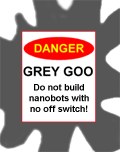Once again we’re at a pivotal point in human development, where a novel technology might allow us to improve the lot of millions, perhaps billions of people across the globe and yet activists are invoking the precautionary principle and informing consumers of the possible dangers therein. As happened with vaccines, nuclear energy, genetically modified crops, stem cells and cloning, and the whole of the chemical and pharmaceuticals industry, they talk of known unknowns, unknown knowns, unknown unknowns and the need to avoid any risk at any price.
The latest scare-mongering is in a similar vein and comes just as the Northern summer reaches its sunniest peak. Apparently some sunscreen manufacturers are already going “nano free” because of activist pressure despite the fact that there is scant evidence that any of the so-called nanoscopic ingredients in modern sunscreens cause any harm whatsoever, while they’re protecting you from harmful sun exposure. It’s odd isn’t it? The marketers and sunscreen and cosmetics manufacturers jumped on the nano bandwagon a decade ago claiming all kinds of miraculous effects for their supposedly new ingredients, and yet today, they’re shying away from them.
In a recent paper in the International Journal of Biomedical Nanoscience and Nanotechnology (2010, 1, 1, 87-94), a lawyer at Australian National University, in Canberra, discusses the issues surrounding nanoparticles and aggregated nanoparticles in sunscreen.
“Currently, no health technology regulator internationally specifies distinct safety regulations or requirements that must be met by manufacturers using ENPs [engineered nanoparticles] in sunscreens or other health products,” he says. However, earlier in his paper Thomas Faunce points out that there are no published research results to suggest adverse effects partly because nanoparticles in sunscreen preparations , specifically zinc oxide and and titanium dioxide while forming free radicals in sunlight undergo “minimal dermal absorption… below the dead and highly keratinised cells of the stratum corneum.”
Am I missing something here? The paper first says that there is no obvious mechanism to suggest any risk other than free radical formation (which is after all caused by the UV absorption) and then suggests we must invoke the precautionary principle just in case. But, why?
Faunce adds that, “No government has yet established regulation to allow the public to make informed choices through proper labelling”. But, I’d like to know what he means by proper labelling. A proper label would perhaps say something like
WARNING This product contains nanoparticles that will protect you from sunlight by absorbing the energy of UV radiation, will only be absorbed by the upper layer of dead skin cells and so should be perfectly safe
Faunce talks of a “significant breakthrough for campaigners against the unregulated use of nanoparticulate sunscreens”, but one has to wonder why anyone should care about campaigners who are basing their concerns on non-facts. So what if apparently iconic sunscreen brands are now touting the fact that they’re nano-free, they know how to follow the market. But, it now means that consumers are left with old school sunscreens. I remember writing for Chemistry and Industry magazine back in the 1990s about evidence that certain conventional sunscreen formulations carried with them a cancer risk because their ingredients were indeed absorbed into deeper layers of the skin, unlike the nanoparticulate formulations.
Faunce refers to the three-quarters of 68 sunscreen brands surveyed as refusing to disclose whether or not their formulations contain nanomaterials and others admitting as if they’re somehow on trial.
I asked nanotechnology expert Andrew Maynard Director of the Risk Science Center at the University of Michigan, to comment on this odd scenario regarding the safety of nano-sunscreens. He points out that Faunce’s article seems to be predominantly focused on the labelling issue and the consumer’s right to know. “This is tricky, as even though the evidence indicates nanomaterials in sunscreens is pretty much a non-issue, there is still a question mark over how consumers and regulators actually know what the active ingredient is,” he told Sciencebase. However, he emphasises that the current state of science strongly indicates that healthy skin is a good barrier against nanoparticle penetration.
Maynard would argue that accurate ingredient identification is important, irrespective of whether the scientific consensus indicates there is a health issue or not. “In the case of nanoparticles in sunscreens, the evidence is strong that there is not a health issue,” he adds. ” Although, as always, there is a little wriggle room for doubt as the research isn’t 100% conclusive – once more a case of more research to dot the i’s and cross the T’s than taking action!” he adds.
Anyway, who said size doesn’t matter? Professor Tilman Butz, who has researched nanoparticle penetration through the skin and is the project leader of the (now complete ) EU Nanoderm Project, posted on Maynard’s blog suggesting that nanoparticles currently used are simply a non-starter when it comes to health issues with sunscreen:
In use are titanium dioxide and sometimes zinc oxide with primary particle sizes around 20 nm. They have a weight in the order of 1 MDa (1 million Daltons = weight of 1 million hydrogen atoms, expressed in molecular terminology although the particles are not molecules). There is general agreement that 0,5 kDa is the upper limit for dermal penetration. Hence, these particles are much too large (heavy) for dermal penetration.
In a climate where cancer organisations are forever trying to convince to avoid sun exposure (that’s another story: skin cancer and sun exposures ), one really has to wonder at the sense of activists trying to get active and useful materials removed from products that are purely a lifestyle choice in the first place. It’s not as if the manufacturers are forcing toxic sunscreen down our throats as they did with melamine contaminant in China not so long ago.
As far as I can tell, nano-sunscreens are more protective and companies who laid their towel on the best loungers by the pool earliest are now back pedalling purely for marketing purposes not because of the precautionary principle or any shift in safety knowledge.
![]() Thomas Faunce (2010). Exploring the safety of nanoparticles in Australian sunscreens Int. J. Biomed. Nanosci. Nanotechnol., 1 (1), 87-94
Thomas Faunce (2010). Exploring the safety of nanoparticles in Australian sunscreens Int. J. Biomed. Nanosci. Nanotechnol., 1 (1), 87-94
 Challenging natural products succumb to radical synthetic prowess, the Alchemist hears this week, while US researchers find a way to construct macroscopic crystals from tiny DNA triangles.
Challenging natural products succumb to radical synthetic prowess, the Alchemist hears this week, while US researchers find a way to construct macroscopic crystals from tiny DNA triangles. Pregnant pause for thought – The analytical cousin of magnetic resonance imaging, NMR spectroscopy, has revealed that a chemical compound found in unpasteurised food can be present at unusually high levels in the red blood cells of pregnant women. The compound, the antioxidant ergothioneine, could be used as a biomarker for the potentially fatal condition, pre-eclampsia, which can cause severely raised blood pressure during pregnancy, according to the researchers, although they explain that the compound is probably not the cause of the disorder.
Pregnant pause for thought – The analytical cousin of magnetic resonance imaging, NMR spectroscopy, has revealed that a chemical compound found in unpasteurised food can be present at unusually high levels in the red blood cells of pregnant women. The compound, the antioxidant ergothioneine, could be used as a biomarker for the potentially fatal condition, pre-eclampsia, which can cause severely raised blood pressure during pregnancy, according to the researchers, although they explain that the compound is probably not the cause of the disorder.



 I got a chance to see pioneering supramolecular chemistry supremo, Professor Sir Fraser Stoddart of UCLA on the Cambridge leg of his UK tour on Monday. Sir Fraser took us on a whirlwind tour of the last quarter century of interlocking ring-shaped compounds, molecular dumbbells and the potential of collections of such entities to bring us the next generation of computer memory that could be fast, high density, and even error self-correcting.
I got a chance to see pioneering supramolecular chemistry supremo, Professor Sir Fraser Stoddart of UCLA on the Cambridge leg of his UK tour on Monday. Sir Fraser took us on a whirlwind tour of the last quarter century of interlocking ring-shaped compounds, molecular dumbbells and the potential of collections of such entities to bring us the next generation of computer memory that could be fast, high density, and even error self-correcting.